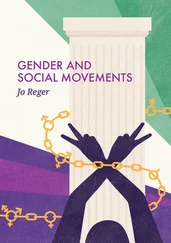1 ...7 8 9 11 12 13 ...16 References
Brown, Penelope and Stephen Levinson (1987). Politeness. Some Universals of Language Use . Cambridge: Cambridge University Press.
Cabellos Castilla, María Rosa and Mercedes Díez Prados (2000). “Women and Language in Female Magazines”. In Bengoechea Bartolomé, Mercedes y Marisol Morales Ladrón (eds.). Mosaicos y Taraceas: Deconstrucción Feminista de los Discursos del Género. Alcalá de Henares: Servicio de Publicaciones de la Universidad de Alcalá, 161-175.
Constenla, Tereixa (2013). “Menos sexismo en el nuevo diccionario”. El País . 25 de noviembre.
Cornbleet, Sandra and Ronald Carter (2001). The Language of Speech and Writing . London and New York: Routledge.
Currie, Dawn H. (1999). Girl Talk. Adolescent Magazines and their Readers . Toronto: University of Toronto Press.
— (2001). “Dear Abby: Advice pages as a site for the operation of power”. Feminist Theory 2, 259-281.
Eckert, Penelope (2006). ‘Communities of practice’ (Accessed 1 November 2013).
Eckert, Penelope and Sally McConnell-Ginet (1992). “Think practically and look locally: Language and gender as community-based practice”. Annual Review of Anthropology 21, 461-490.
— (2013). Language and Gender 2nd ed. Cambridge: Cambridge University Press.
Evans, Ellis D. et al . (1991). “Content analysis of contemporary teen magazines for adolescent females”. Youth and Society 23(1), 99-120.
García Gómez, Antonio (2006). “Sneaking gender into the EFL class”. Porta Linguarum 5, 77-89.
— (2009). “Teenage girls’ personal weblog writing”. Information, Communication & Society 12(5), 611-638.
— (2010). “Disembodiment and cyberspace: gendered discourses in female teenagers’ personal information disclosure”. Discourse & Society 2(2), 135-160.
GL [ Girls’ Life Magazine ] ‘Snag that job: dos and don’ts’. Advice web.’ < http://www.girlslife.com/post/2009/09/03/getting-jobdos-donts.aspx> (Accessed 23 September, 2013).
Goleman, Daniel (1998). Working with Emotional Intelligence. New York: Bantam Books.
Jackson, Sue (2005). “ ‘Dear Girlfiend…’: Constructions of sexual health problems and sexual identities in letters to a teenage magazine”. Sexualities 8, 282-305.
Jiménez Calderón, Francisco and Anna Sánchez Rufat (2011).
“Lengua y revistas para adolescentes: hacia la construcción del modelo”. Anuario de Estudios Filológicos 34, 53-65.
Joshi, Saroj, P. (2012). Adolescent Sexual Socialization & Teen Magazines: A cross-national Study between the United States and the Netherlands . Doctoral Dissertation, University of Amsterdam < http://dare.uva.nl/record/417928> (Accessed 1 November 2013).
Kruse, Lenelis, Ernst Weimer and Franc Wagner (1988). “What men and women are said to be: social representation and language”. Journal of Language and Social Psychology 7(3), 243-62.
The Henry J. Kaiser Family Foundation (2004). ‘Tweens, Teens, and Magazines’ < http://kaiserfamilyfoundation.files.wordpress.com/2013/01/tweens-teens-and-magazines-fact-sheet.pdf> (Accessed 26 July, 2013)
López Rodriguez, Irene (2007). “The representation of women in teenage and women’s magazines: recurring metaphors in English”. Estudios Ingleses de la Universidad Complutense 15, 15-42.
Medley-Rath, Stephanie R. (2007). “ ‘Am I still a virgin?’: What counts as sex in 20 years of Seventeen ”. Sex Cult 11, 24-38.
Pierce, Kate (1990). “A feminist theoretical perspective on the socialization of teenage girls through Seventeen magazine”. Sex Roles 23(9/10), 491-500.
Plaza Sánchez, Juan F. (2005). Modelos de Varón y Mujer en las Revistas Femeninas para Adolescentes. La Representación de los Famosos . Madrid: Editorial Fundamentos.
— (2009). “La globalización de la identidad de género en las revistas para las adolescentes”. Zer 14(26), 129-144.
Sacks, Harvey, Emanuel Schegloff, and Gail Jefferson (1974). “A simplest systematics for the organization of turn-taking for conversation”. Language 50(4), 696-735.
Saz Marín, Ana Isabel (2007). S.O.S. Adolescentes […y de Repente Llega un Día en el que no lo Reconoces]. Madrid: Aguilar.
Signorelli, Nancy (1997). ‘A content analysis: reflections of girls in the media. A study of television shows and commercials, movies, music videos, and teen magazine articles and ads’, The Kaiser Family Foundation and Children Now (Accessed 10 March, 2010).
Tsui, Amy B. M. (1994). English Conversation . Oxford: Oxford University Press.
Yule, George (1996). Pragmatics . Oxford: Oxford University Press. Print.
Acknowledgements: The present study was financially supported by a grant(ID No:FFI2013-47792-C2-2-P)from the Ministerio de Economía y Competitividad. This article is part of the long-term research project “EMotion and language ‘at work’: The discursive emotive/evaluative FUNction in different texts and contexts within corporate and institutional work: PROject PERsuasion” (EMO-FUNDETT: PROPER).
1Following García Gómez (2010: 136), gender readership was determined by “explicit gender statements (…) and gender-indexical language”.
2This “close reading” follows the methodology in Currie’s study (2001), whose conclusions are based on the close reading of two texts. The present study, although cannot be considered quantitative, analyzes a larger corpus. For a quantitative study, a much larger sample of texts should have been analysed; notwithstanding, a larger corpus would not have allowed to apply this qualitative methodology.
2
Official and unofficial propaganda: old sexism (and, racism and classism) in new guises
JOANNE NEFF VAN AERTSELAER
Universidad Complutense de Madrid
Abstract
This article traces the connection between propaganda, understood as promoted by the state or institutions, and commercial advertising. Both types of messages use similar techniques –establish authority, exploit existing beliefs, create fear, imply that everyone agrees, be selective about the truth, establish a leadership cult, etc. From a gender point of view, it can be shown that when the messages are directed towards women, they are principally concerned with instructing women as to their proper place in society, and/or they are meant to support men’s self-image, as masculine. The article also includes a brief comparison of propaganda used by the Francoist government and the UK and US government during WWI and WWII.
Keywords : Sexist political propaganda, sexist advertising, power, propaganda.
1 Introduction
This article analyzes various types of propaganda (promoted by the State or institutions), and its “cousin”, commercial advertising, both in official and unofficial campaigns, with the purpose of showing that both types of advertising are/have been targeted more at women than at men and that the messages used by both types of campaigns actually coincide in the techniques they use, which are essentially the same. But, more importantly, from a gender point of view, these two types of advertising converge in that they consider women in light of the two polar social functions, neither of them essential to society: 1) women must be “instructed” as to how they are to carry out their lives –good mothers, efficient wives, beautiful and stylish, etc.; and, 2) women are objects that men use in order to enhance their reputation with other men (Beneke 1997). If the woman is a girlfriend or wife, she may be expected to be very proper, but in any case, she must be beautiful and at least covertly sexy.
Читать дальше












